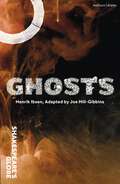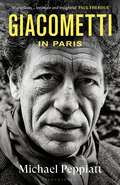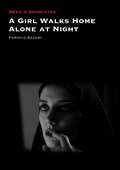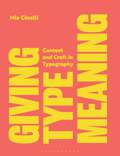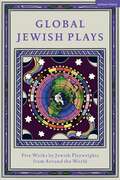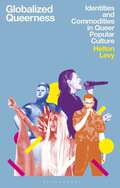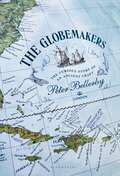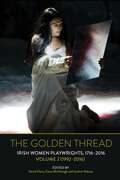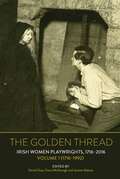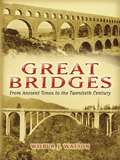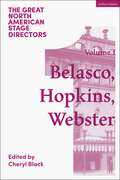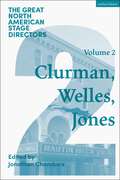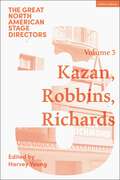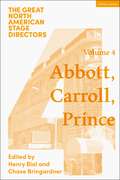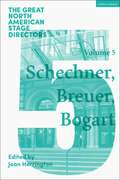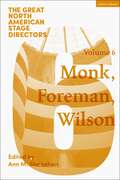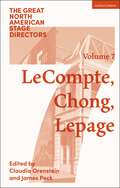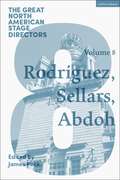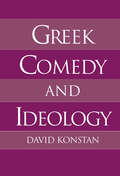- Table View
- List View
Ghosts (Modern Plays)
by Henrik IbsenThere are ghosts everywhere. There are ghosts here right now.Plagued by the ugly truth of her late husband's legacy, Helene vows to erase the past and start again.Ignorant to the reality of his father's character, Osvald, her son, returns home to face an uncertain future. But when the ember of an illicit romance stands to ruin Helene's plans to play happy family, she is forced to make a decision that threatens to engulf what's left of her – and her son's – life completely.Experience the work of Henrik Ibsen, one of the most influential dramatists of all time, in a scandalous and searing exploration of family secrets and forbidden desire. Nearly 150 years after causing a furore when it premiered with its depiction of incest, infection and euthanasia, adaptor and director Joe Hill-Gibbins (The Marriage of Figaro, ENO; The Tragedy of King Richard The Second, Almeida), in his Globe debut, brings a new version of Ghosts, the first modern tragedy, to the Sam Wanamaker Playhouse.Ghosts was part of the Sam Wanamaker Playhouse 10th Anniversary Season. This edition was published to coincide with the world premiere at The Globe's Sam Wanamaker Playhouse in November 2023.
Giacometti in Paris
by Michael Peppiatt'Marvellous . . . intimate and insightful . . . reads like a novel by Samuel Beckett' Paul Theroux A portrait of one of the twentieth century's greatest sculptors from one of our most eminent art historiansToday the work of Alberto Giacometti is world-famous and his sculptures sell for record-breaking prices. But from his early days as an unknown outsider to the end of a dramatic international career, Giacometti lived in the same hovel of a studio in Paris. It was Paris that made him, and he in turn immortalised the city through his art.Arriving in Paris from the Swiss Alps in 1922, Giacometti was shaped not only by his relationships with remarkable artists and writers – from Picasso, Breton and Dalí to Sartre, Beauvoir and Beckett – but by the everyday life, pre-war and post-war, of Paris itself. His distinctive figures emerged from the city's unique atmosphere: the crumbling grey stone of its humbler streets and the café-terraces buzzing with radical ideas and racy gossip.In Giacometti in Paris, Michael Peppiatt, who spent thirty years documenting the Parisian art world and mixing with many of the people Giacometti knew, brilliantly charts the course of the artist's life and work. From falling in and out with the Surrealists to years of artistic anguish, from devotion to his mother to intense friendships, tragic love affairs and a fraught marriage, this is an intimate portrait of an outstanding artist in exceptional times.
A Girl Walks Home Alone at Night (Devil's Advocates)
by Farshid KazemiThere is something weird and eerie going on in the oneiric Iranian ghost-town Bad City. A mysterious female vampire, clad in a long-black veil, imbued with occult and erotic power, has newly arrived in town and is summarily dispensing with its unsavory characters. Through a chance encounter in a night of luminal darkness, an eternally dark romance begins – baptized in love’s blood. Shot in dazzling anamorphic black and white cinematography and accompanied with an intoxicating and mesmeric soundtrack, Ana Lily Amirpour’s debut feature film A Girl Walks Home Alone At Night (2014), was an instant popular and critical success. Dubbed ‘the first Iranian vampire western’ the genre-bending film is a pastiche of genres such as vampire cinema, gothic and horror films, spaghetti westerns, graphic novels, and Iranian cinema; yet the film stands as a new vampire fairy-tale with a unique style all its own. The first full-length study dedicated to the film since its release, this book in the Devil’s Advocate series provides a unique approach to the film situated within three theoretical coordinates: the vampire genre, psychoanalytic (film) theory and German Idealism.
Giving Type Meaning: Context and Craft in Typography
by Mia CinelliWhen we encounter typography, how do we know what it means? How is the tone of type influenced by the way it is set, when it is made, and where it exists? Considering the social, spatial, and temporal contexts of visual language, this text informs and inspires students, educators, and professionals looking to engage more deeply with the letterforms they use and see. Featuring diverse typographic works, “closer looks”, and interviews with practicing artists and designers, Giving Type Meaning serves to inform how and why we understand what type communicates. The book includes: - The importance and impact of cultural and social context across the expanded field of art and design- How to use visual, physical, and gestural space to inform meaning- The ways time impacts type, such as historical references, recontextualizations, and the use of time as medium - A range of global examples, including Lushootseed language letterforms (Lushootseed Sulad by Juliet Shen), Arabic calligraphy and type design (Regard Each Other as Brothers by Josh Berer, Mirsaal by Rana Abou Rjeily), American civil rights inspired type (Martin by Tré Seals), Italian concrete poetry (Storia Del Monumento by Mirella Bentivoglio), and animated Chinese characters (Motion Type Project by Ting-An Ho)
Global Jewish Plays: Extinct; Heartlines; The Kahena Berber Queen; Papa’gina; A People (Methuen Drama Play Collections)
by Berthe Bénichou-Aboulker Hana Vazana Grunwald Sarah Waisvisz Philip Arditti L M FeldmanA unique collection of plays that brings together stories of Jewish life from playwrights around the world. Curated and edited by an international theatre collective, these five plays showcase the dazzling multiplicity of Jewish narratives across the globe: the haunting, the challenging, the joyful. From a legendary North African warrior queen to queer French avant-garde artists during World War II; from Israel-Palestine tensions made personal to protests in Istanbul amidst intergenerational trauma, this is a genre-spanning collection that probes at the heart of what it means to be Jewish - past, present, and future. Curated by Jewish-Lebanese Brazilian queer theatre maker, the plays were performed at London's Bush Theatre as part of Global Voices Theatre's popular live events. At a sensitive time for Jewish communities in the UK and beyond, the original event Global Jewish Voices aimed to engage the UK Jewish community and make space for nuanced conversations and representation. This collection of selected plays is a legacy of the event and opens up avenues for wider audiences to read and perform the works.
Globalized Queerness: Identities and Commodities in Queer Popular Culture (Library of Gender and Popular Culture)
by Helton LevyHas a global queer popular culture emerged at the expense of local queer artists? In this book, Helton Levy argues that global queer culture is indebted to specific, local references that artists carry from their early experiences in life, which then become homogenized by contemporary media markets. The assumption that queer publics live and consume only through a global set of references, including gay parades and rainbow flags, for example, erases many personal complexities.Levy revisits media characters that have caught the attention of the broader public – such as Calamity Jane (1953), the Daffyd Thomas character from the BBC comedy Little Britain (2003-2007), Brazilian drag queen Pabblo Vittar, French singer Christine and the Queens, and the Italian-Egyptian rapper Mahmood – and argues that they have gradually blended in the public's perception. This has often obscured the individual struggles faced by these characters, such as immigration, homophobia, poverty and societal exclusion. Levy also questions what happens when global media flows take queer culture to regions wherein the notion of LGBTQ+ rights are not entirely acceptable. Utilizing insights from media reports published across the world's ten biggest media markets, Levy argues that there are a series of conditions which artists and cultural actors negotiate once they achieve any kind of success in mainstream media, while local queer references remain unseen in the wider media world. For that reason, he argues for stronger incentives for communities to accept and acknowledge the work of queer people before and after commoditization.
The Globemakers: The Curious Story of an Ancient Craft
by Peter BellerbyThe beautiful illustrated story of our globe and the creations it has inspired, told by the only truly bespoke globemakers in the world, Bellerby & Co. Globemakers'The untold story of the globe, this book is a glorious spyhole into a forgotten art' - Lara Maiklem, author of Mudlarking Peter Bellerby is the founder of Bellerby & Co. Globemakers, the world's only truly bespoke makers of globes. His team of skilled craftspeople make exquisite terrestrial, celestial and planetary globes for customers around the world. The story began after his attempt to find a special globe for his father's 80th birthday. Failing to find anything suitable, he decided to make one himself which took him on an extraordinary journey of rediscovering this forgotten craft.The chapters of The Globemakers take us through the journey of how to build a globe, or 'earth apples' as they were first known, and include fascinating vignettes on history, art history, astronomy and physics, as well as the day-to-day craftsmanship at the workshop itself.This beautiful book uses illustration, photography and narrative to tell the story of our globe and many different globes it has inspired.---------'A book as beautiful as the craft it describes, The Globemakers is an inspirational story of a craftsman's dogged pursuit for perfection. It's written with the intricacy of someone who can capture the fine details of our vast planet in something small enough to sit on your desk' - Rebecca Struthers, author of The Hands of Time'Absolutely fascinating from beginning to end - an adventure like no other!' - Alice Loxton
Golden Gate Bridge, USA (Large Print)
This image shows the 2.7 kilometre long Golden Gate suspension bridge. It spans the width of the page and is bounded by a dashed line image border. There is a locator dot shown, which will be at the top left of the page when the image is the right way up. Along the bottom of the image is the water. Just up from this on the left side of the page is a small piece of land and one end of the bridge's roadway. Right from this is a small arch reaching up from the water then a tall tower supporting the main suspension cables, which curve down and rise up again to another tall tower on the right of the page. The roadway is suspended from vertical cables attached to the main cables and continues to another piece of land on the right of the page.
Golden Gate Bridge, USA (UEB Contracted)
This image shows the 2.7 kilometre long Golden Gate suspension bridge. It spans the width of the page and is bounded by a dashed line image border. There is a locator dot shown, which will be at the top left of the page when the image is the right way up. Along the bottom of the image is the water. Just up from this on the left side of the page is a small piece of land and one end of the bridge's roadway. Right from this is a small arch reaching up from the water then a tall tower supporting the main suspension cables, which curve down and rise up again to another tall tower on the right of the page. The roadway is suspended from vertical cables attached to the main cables and continues to another piece of land on the right of the page.
Golden Gate Bridge, USA (UEB uncontracted)
This image shows the 2.7 kilometre long Golden Gate suspension bridge. It spans the width of the page and is bounded by a dashed line image border. There is a locator dot shown, which will be at the top left of the page when the image is the right way up. Along the bottom of the image is the water. Just up from this on the left side of the page is a small piece of land and one end of the bridge's roadway. Right from this is a small arch reaching up from the water then a tall tower supporting the main suspension cables, which curve down and rise up again to another tall tower on the right of the page. The roadway is suspended from vertical cables attached to the main cables and continues to another piece of land on the right of the page.
The Golden Thread: Irish Women Playwrights, Volume 2 (1992-2016)
This two-volume edited collection illuminates the valuable counter-canon of Irish women’s playwriting with forty-two essays written by leading and emerging Irish theatre scholars and practitioners. Covering three hundred years of Irish theatre history from 1716 to 2016, it is the most comprehensive study of plays written by Irish women to date. These short essays provide both a valuable introduction and innovative analysis of key playtexts, bringing renewed attention to scripts and writers that continue to be under-represented in theatre criticism and performance. Volume Two contains chapters focused on plays by sixteen Irish women playwrights produced between 1992 and 2016, highlighting the explosion of new work by contemporary writers. The plays in this volume explore women’s experiences at the intersections of class, sexuality, disability, and ethnicity, pushing at the boundaries of how we define not only Irish theatre, but Irish identity more broadly.CONTRIBUTORS: Nelson Barre, Mary Burke, David Clare, Shonagh Hill, Mária Kurdi, José Lanters, Fiona McDonagh, Dorothy Morrissey, Justine Nakase, Brian Ó Conchubhair, Brenda O'Connell, Shane O'Neill, Graham Price, Siobhán Purcell, Carole Quigley, Sarah Jane Scaife, Melissa Sihra, Clare Wallace
The Golden Thread: Irish Women Playwrights, Volume 1 (1716-1992)
This two-volume edited collection illuminates the valuable counter-canon of Irish women’s playwriting with forty-two essays written by leading and emerging Irish theatre scholars and practitioners. Covering three hundred years of Irish theatre history from 1716 to 2016, it is the most comprehensive study of plays written by Irish women to date. These short essays provide both a valuable introduction and innovative analysis of key playtexts, bringing renewed attention to scripts and writers that continue to be under-represented in theatre criticism and performance.Volume One covers plays by Irish women playwrights written between 1716 to 1992, and seeks to address and redress the historic absence of Irish female playwrights in theatre histories. Highlighting the work of nine women playwrights from the eighteenth and nineteenth centuries, as well as thirteen of the twentieth century’s key writers, the chapters in this volume explore such varied themes as the impact of space and place on identity, women’s strategic use of genre, and theatrical responses to shifts in Irish politics and culture.CONTRIBUTORS: Conrad Brunström, David Clare, Thomas Conway, Marguérite Corporaal, Mark Fitzgerald, Shirley-Anne Godfrey, Úna Kealy, Sonja Lawrenson, Cathy Leeney, Marc Mac Lochlainn, Kate McCarthy, Fiona McDonagh, Deirdre McFeely, Megan W. Minogue, Ciara Moloney, Justine Nakase, Patricia O'Beirne, Kevin O'Connor, Ciara O'Dowd, Clíona Ó Gallchoir, Anna Pilz, Emilie Pine, Ruud van den Beuken, Feargal Whelan
The Gothic Peckinpah
by Tony WilliamsThis book argues for the importance of Gothic in understanding one of the key elements within the films of Sam Peckinpah (1925-1984). Although occasionally noted in the past, the Gothic has been generally overlooked when most critics consider the work of Sam Peckinpah with the exception of the Freudian based Crucified Heroes (1979) by Terence Butler. This work not only examines the films made after that date, especially the often dismissed The Osterman Weekend (1983) and the two music videos he made for Julian Lennon, but also places the director within the context of the developing work on Gothic that has since appeared. Peckinpah has been identified as the director of one undisputed masterpiece, The Wild Bunch (1969). By focussing on the key role Gothic plays in most of the director’s work, this book offers a way to see Peckinpah beyond The Wild Bunch and the Western, viewing him as a director who had the potential of evolving further, had circumstances permitted, to continue his critique of American life within the developing lens of the Gothic.
Graffiti Planet: The Best Graffiti from Around the World
by Alan KetA celebration of the creativity of graffiti artists from all over the world.Ever controversial, graffiti or street art has become a significant art form and continues to evolve and transform urban landscapes in cities around the globe.Compiled by an insider on the New York graffiti scene, KET, this is a collection of the work of some of the world’s top graffiti artists.Showcases work from artists such as Banksy (London), Can2 (Munich), T-Kid (New York), Os Gemeos (Sao Paolo) and many more.Graffiti Planet is a perfect companion to this dynamic and vibrant art form.
Great Bridges: From Ancient Times to the Twentieth Century
by Wilbur J. WatsonBridges serve a practical purpose, providing passage over rivers, valleys, roads, railroad tracks, and other obstacles to transportation. But many bridges are also works of art. This splendid archive by an expert on the history of bridges and civil engineering amply illustrates the art of good bridge design, as exemplified by ancient and modern constructions. Wilbur J. Watson's study ranges far and wide, and his text -- accompanied by 200 rare photographs and illustrations -- contains vivid descriptions of many of the Old and New World's finest bridges, as well as historical data, and considerable literary and legendary lore.Bridges of all purposes and sizes are considered--from stone viaducts in Roman Iberia and Chinese masonry arches of the Han dynasty to the pontoon spans of Asia Minor and the modern steel and concrete suspension bridges in Geneva, Switzerland, and in New York. Here also are views of the Old London Bridge (1209), the Karlsbrücke in Prague, the imposing 14th-century Valentré bridge in Cahors, France, and scores more.A fact-filled pictorial guide, this volume will be welcomed by students of engineering and architecture, and anyone who has ever marveled at the size and grandeur of a well-built bridge.
Great North American Stage Directors Volume 1: David Belasco, Arthur Hopkins, Margaret Webster (Great Stage Directors)
by Professor James PeckThis volume assesses the contributions of David Belasco, Arthur Hopkins, and Margaret Webster, whose careers shaped the artistic and specialist identity of the Broadway director. Their work spans almost a century and captures the rapidly changing social and cultural landscape of 20th-century America. While their aesthetic styles differed greatly, they were united in their mastery of theatre craft and their impact on theatrical collaboration. The essays in this volume explore how these directors established and exploited Broadway as the epicentre of theatre in the United States, blended the role of producer and director, and managed the tensions between commercial success and artistic ambition.The Great North American Stage Directors series provides an authoritative account of the art of directing in North America by examining the work of twenty-four major practitioners from the late 19th century to the present. Each of the eight volumes examines three directors and offers an overview of their practices, theoretical ideas, and contributions to modern theatre. The studies chart the life and work of each director, placing his or her achievement in the context of other important theatre practitioners and broader social history. Written by a team of leading experts, the series presents the genealogy of directing in North America while simultaneously chronicling crucial trends and championing contemporary interpretation.
Great North American Stage Directors Volume 2: Harold Clurman, Orson Welles, Margo Jones (Great Stage Directors)
by Professor James PeckThis volume assesses the accomplishments of three mid-20th century, North American stage directors: Harold Clurman, Orson Welles, and Margo Jones. Though their theatre-making endeavours were distinct, each produced work that challenged preconceived notions of theatre-making, all while working within the structure of a company. As directors drawn to the potential rewards of collaboration, all also were keenly adept at understanding how the relationship with a company of collaborators is often marked by struggle and crisis. The essays in this volume explore how these accomplished directors not only created bold work, but also drew on the complex energies of the theatre companies with which they worked to reimagine the shape and scope of theatre directing.The Great North American Stage Directors series provides an authoritative account of the art of directing in North America by examining the work of twenty-four major practitioners from the late 19th century to the present. Each of the eight volumes examines three directors and offers an overview of their practices, theoretical ideas, and contributions to modern theatre. The studies chart the life and work of each major North American theatre director, placing his or her achievement in the context of other important theatre practitioners and broader social history. Written by a team of leading experts, the series presents the genealogy of directing in North America while simultaneously chronicling crucial trends and championing contemporary interpretation.
Great North American Stage Directors Volume 3: Elia Kazan, Jerome Robbins, Lloyd Richards (Great Stage Directors)
by Professor James PeckThis volume chronicles the lives and artistry of Elia Kazan, Jerome Robbins, and Lloyd Richards. Their commitment to staging new works, which often focused on the experiences of immigrant and working-class families, significantly expanded the scope and possibilities of American theatre across the 20th century. It illuminates too their collaborations with a range of innovative theatre artists, including Lee Strasberg, Clifford Odets, Marlon Brando, Arthur Miller, Tennessee Williams, Lorraine Hansberry, Leonard Bernstein, Stephen Sondheim, and August Wilson.The Great North American Stage Directors series provides an authoritative account of the art of directing in North America by examining the work oftwenty-four major practitioners from the late 19th century to the present. Each of the eight volumes examines three directors and offers an overview of their practices, theoretical ideas, and contributions to modern theatre. The studies chart the life and work of each director, placing his or her achievement in the context of other important theatre practitioners and broader social history. Written by a team of leading experts, the series presents the genealogy of directing in North America while simultaneously chronicling crucial trends and championing contemporary interpretation.
Great North American Stage Directors Volume 4: George Abbott, Vinnette Carroll, Harold Prince (Great Stage Directors)
by Professor James PeckGeorge Abbott, Vinnette Carroll, and Harold (Hal) Prince were trailblazing figures who helped shape and define the Broadway musical over the course of the 20th century. Their careers expanded the boundaries of the genre, highlighting the critical role of the director in the creation of a new musical. As theatre history, the essays in this volume help to complicate and deepen the reader's understanding of the musical genre of Broadway and of the enduring legacies of these three pioneers. As lessons in theatrical direction, they illustrate the particular issues involved in directing musicals, as well as the stakes of working commercially at the highest levels of the industry.The Great North American Stage Directors series provides an authoritative account of the art of directing in North America by examining the work of twenty-four major practitioners from the late 19th century to the present. Each of the eight volumes examines three directors and offers an overview of their practices, theoretical ideas, and contributions to modern theatre. The studies chart the life and work of each director, placing his or herachievement in the context of other important theatre practitioners and broader social history. Written by a team of leading experts, the series presents the genealogy of directing in North America while simultaneouslychronicling crucial trends and championing contemporary interpretation.
Great North American Stage Directors Volume 5: Richard Schechner, Lee Breuer, Anne Bogart (Great Stage Directors)
by Professor James PeckRichard Schechner, Lee Breuer, and Anne Bogart share a spirit of profound adventure and that adventure is the redefinition of theatre itself. They are rare hybrids; the confluence of their theatrical roles as directors, scholars, theorists and teachers has placed them among the most influential thinker/practitioners of their generation. This book reveals the ways in which their consistent inquiry enabled them to re-examine, re-frame, and re-invent their own practice. The essays in this volume explore the ways in which Schechner, Breuer and Bogart have established powerful legacies of consistently innovative theatre most often created in the company of an ensemble of collaborative artists. Their influence is undeniable in the reformulation of theatre practices from the 1970s onward. The Great North American Stage Directors series provides an authoritative account of the art of directing in North America by examining the work of twenty-four major practitioners from the late 19th century to the present. Each of the eight volumes examines three directors and offers an overview of their practices, theoretical ideas, and contributions to modern theatre. The studies chart the life and work of each director, placing his or her achievement in the context of other important theatre practitioners and broader social history. Written by a team of leading experts, the series presents the genealogy of directing in North America while simultaneously chronicling crucial trends and championing contemporary interpretation.
Great North American Stage Directors Volume 6: Meredith Monk, Richard Foreman, Robert Wilson (Great Stage Directors)
by Professor James PeckThis volume assesses the work of Meredith Monk, Richard Foreman, and Robert Wilson, three artists who have revolutionized the craft of directing and the art of theatre in both related and unique ways. Though their early artistic backgrounds differ, ranging from architecture, music and dance to writing, they are similar in that none of them began their career as a director per se or received formal training as such. They each assumed the director's role based on the demands of their complex artistic visions, which combine art forms, but resist synthesis, finding expression in the differences and tensions between the forms. The essays in this volume explore how these auteur directors combine text, movement, film, sound and music, installation and visual arts to achieve their visions, employing multi-perceptual modes to evoke full and rich theatrical experiences. The Great North American Stage Directors series provides an authoritative account of the art of directing in North America by examining the work of twenty-four major practitioners from the late 19th century to the present. Each of the eight volumes examines three directors and offers an overview of their practices, theoretical ideas, and contributions to modern theatre. The studies chart the life and work of each director, placing his or her achievement in the context of other important theatre practitioners and broader social history. Written by a team of leading experts, the series presents the genealogy of directing in North America while simultaneously chronicling crucial trends and championing contemporary interpretation.
Great North American Stage Directors Volume 7: Elizabeth LeCompte, Ping Chong, Robert Lepage (Great Stage Directors)
by Professor James PeckThis volume focuses on three artists who embrace media and technology as essential elements of their theatrical expression: Elizabeth LeCompte, Ping Chong, and Robert Lepage. Diverse in their aesthetic interests, they nevertheless share an approach to directing that includes technological media on stage as central to a rigorously crafted production concept. Technological elements live alongside and negotiate with the theatre's human players, disclosing, shaping, and even intruding on the dramas they enact. The essays in this volume explore how all three directors have provided decisive responses to a question that has dogged the theatre for at least the last century: what relationship can theatre, an art form grounded in live, ephemeral, expression, have to technology?The Great North American Stage Directors series provides an authoritative account of the art of directing in North America by examining the work of twenty-four major practitioners from the late 19th century to the present. Each of the eight volumes examines three directors and offers an overview of their practices, theoretical ideas, and contributions to modern theatre. The studies chart the life and work of each director, placing his or her achievement in the context of other important theatre practitioners and broader social history. Written by a team of leading experts, the series presents the genealogy of directing in North America while simultaneously chronicling crucial trends and championing contemporary interpretation.
Great North American Stage Directors Volume 8: Jesusa Rodriguez, Peter Sellars, Reza Abdoh (Great Stage Directors)
by Professor James PeckThe three directors gathered in this volume all approach theatre-making in part as an act of citizenship. Jesusa Rodríguez, Peter Sellars, and Reza Abdoh differ markedly in many important respects, but they all come to the theatre as an intervention in the public sphere. Rodríguez, Sellars, and Abdoh blend a spirit of social critique with acts of democratic community building. These essays examine how theatre, for them, is not a sphere of aesthetic experience insulated from the divisions, antagonisms, and alliances of a conflicted society. It is a way to forge fleeting but consequential communities that might reverberate through that society and affect its future development.The Great North American Stage Directors series provides an authoritative account of the art of directing in North America by examining the work of twenty-four major practitioners from the late 19th century to the present. Each of the eight volumes examines three directors and offers an overview of their practices, theoretical ideas, and contributions to modern theatre. The studies chart the life and work of each director, placing his or her achievement in the context of other important theatre practitioners and broader social history. Written by a team of leading experts, the series presents the genealogy of directing in North America while simultaneously chronicling crucial trends and championing contemporary interpretation.
Green Gifts: 40 Sustainable and Beautiful Present Ideas
by Rosie James Claire CaterFrom homemade spa-day pamper products to gorgeous homewares, these 40 eco-gifting ideas will show you how to create presents from everyday household items. Whether you're eco-conscious and keen to reduce your plastic usage or want to be more sensible with your spending, this gorgeous craft compendium provides step-by-step guides to produce gifts that don't compromise on design or quality. Presents for sustainable living Home-grown plants and succulents from cuttings Self-care treatsOn-the-go necessities Special occasions Presents for furry loved ones … as well as tips and tricks on creating your own wrapping paper and gift tags, and much more besides. You'll be able to create modest yet striking products from items in your home and reward friends and family with carefully made contemporary treats. And by replacing disposable presents with recycled, eco-friendly ones that have been hand-made from materials in your home, you'll be saving your pennies while saving the world. The ultimate guide to eco-living and giving.
